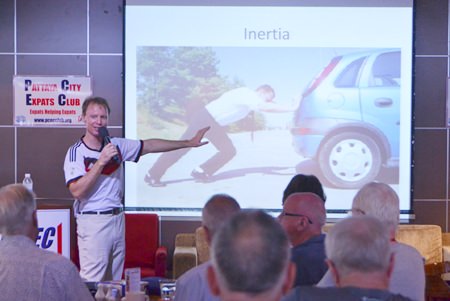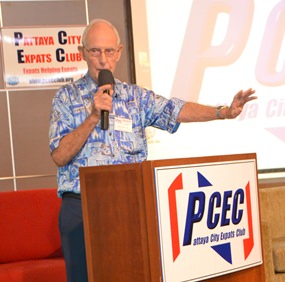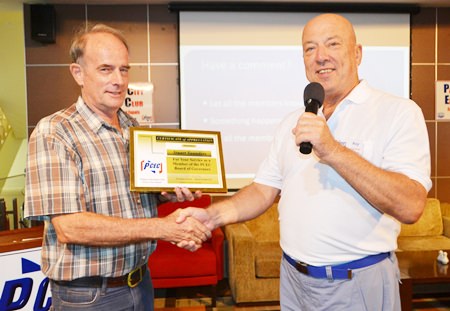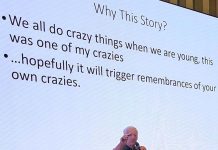Positive change may take a quantum leap to achieve. Try watching a slow-motion video of a horse racing. You will see that there are moments when the horse’s feet don’t touch the ground. The horse is not really running; rather, it is taking a series of jumps. That’s an example in nature of the law of quantum leaps, according to Ren Lexander, speaker at the Sunday, August 3, meeting of the Pattaya City Expats Club. Ren is an Australian with a PhD in philosophy and a varied work career, including running a large property-development business. He is the author of seven books.
Ren said that he had been thinking for many years about what factors lead to success and what factors result in failure, and that’s when he came up with the idea of the law of quantum leaps (which also includes the law of quantum slumps). Further, that the law of quantum leaps is one of 25 laws of life that he has identified. Other laws of life include the law of attitude, the law of individuality and the law of will.
 PCEC member Ren Lexander explains how his Law of Quantum Leaps can be used to achieve positive change in your life.
PCEC member Ren Lexander explains how his Law of Quantum Leaps can be used to achieve positive change in your life.
Ren’s theory is that if you want to change anything for the better – a business, your fitness, your health, your skill level, a relationship; anything – understanding and applying the law of quantum leaps can help you make effective positive change. According to the law of quantum leaps, things don’t change by sliding up or down; they jump up levels and fall down levels. Also, to instigate positive change, one needs to apply large amounts of energy in a condensed time frame.
The conventional wisdom is that nature does not jump. Ren said that the law of quantum leaps challenges that assumption. In quantum mechanics, for example, to get an electron to move from one shell to another requires a sudden burst of energy. Objects and people resist movement because of inertia. Try to push a car that is standing in one spot, or trying to get a friend to change a particular behaviour, requires overcoming this inertia. It requires a burst of energy in a condensed time frame – a quantum leap. Ren felt that people don’t tend to recognize jumps. The human brain smoothes things over, rather like watching a film which gradually unfolds in front of your eyes.
Ren identified five stages of quantum leaps: 1) The pre-existing stable ordered state; 2) The concentrated input of energy/effort/nourishment; 3) The time lag; 4) The quantum jump to a higher level; and 5) Stability at a higher level (if you can maintain it there).
The opposite of a quantum leap is a quantum slump. The five stages of quantum slumps look like this: 1) A pre-existing stable ordered state; 2) A period of deprivation (mis-nourishment, under-nourishment, hostile environment, etc.); 3) A time lag where the thing holds onto its current state until it can no longer do so; 4) Quantum slump to a lower level; and 5) Stability at the lower level (if you can keep it from falling further).
One example of a quantum slump is: You have osteoporosis; your hip breaks and you take a bad fall. Another example is related to relationships: You’re married and things seem to be going okay; then, suddenly, husband and wife realize they are not connecting anymore.
 Ren Lexander illustrates to the PCEC his point about the need to overcome inertia if you want to make a quantum leap.
Ren Lexander illustrates to the PCEC his point about the need to overcome inertia if you want to make a quantum leap.
To explain quantum leaps further, Ren brought up the so-called “10,000 hour rule.” Experts have estimated that it takes about 10,000 hours of practice to become “elite.” Ren said that rule only applies if the practicing is done in a condensed time frame. A student who practices 30 hours a week for six-and-a-half-year period (total: 10,140 hours) could become an elite violinist. But someone who puts in that many hours of practice over 30 years won’t ever become an elite violinist.
 PCEC Vice Chairman Richard Smith invites everyone to join him in a tour he arranged of the Holiday Inn’s new Executive Tower to take place immediately after the PCEC meeting.
PCEC Vice Chairman Richard Smith invites everyone to join him in a tour he arranged of the Holiday Inn’s new Executive Tower to take place immediately after the PCEC meeting.
Ren said that when, early in their career, the Beatles got an opportunity to play in clubs in Hamburg, Germany, they played for at least five hours a day, seven days a week. In his opinion that this kind of concentrated effort is what made the Beatles so good; a quantum leap.
When it comes to health and fitness, Ren stated that quantum leaps are not about maintenance. Rather, they are about short, condensed bursts of energy. Quantum leaps can mean different things for different people. For a couch potato, Ren said, a quantum leap can mean taking a walk around the block. Ren said that we was working on a screenplay and not making much progress. He decided to do it in quantum bursts and that got the job done. Ren showed a short video of him performing a dance with a partner. He said that he used short but significant bursts of effort in a concentrated period to learn how to dance.
Ren said that you can apply the law of quantum leaps to all areas of your life to make a positive change. For more information about Ren, visit his website www. renlexander.com.
After Ren answered many questions from the audience, Master of Ceremonies Richard Silverberg brought everyone up to date on upcoming events and called on Roy Albiston to conduct the always informative Open Forum where questions are asked and answered about Expat living in Thailand, especially Pattaya.
For more information on the PCEC’s many activities, visit their website at www.pcecclub.org.
 PCEC Chairman Roy Albiston (right) gives a certificate of appreciation to member Stuart Saunders (left) in recognition for his six years as the Club’s Vice Chairman. Stuart stepped down from the Board of Governors this year because of other commitments.
PCEC Chairman Roy Albiston (right) gives a certificate of appreciation to member Stuart Saunders (left) in recognition for his six years as the Club’s Vice Chairman. Stuart stepped down from the Board of Governors this year because of other commitments.




